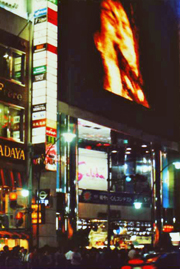平成1年8月2日 (水)
Dateline: Wednesday August 2, 1989
Accounts
| ¥300 | 5 postcards |
| ¥9 | consumption tax |
| ¥200 | 2 machine-drink colas |
| ¥4000 | Sushi dinner with Oita-ken JETs |
| ¥4509 | Total: $51.00 |
Orientation and Disorientation
We wake up around 5AM Tokyo time. It’s too early for breakfast (we have an assigned time so that the hotel can handle our ravenous horde in a orderly fashion), so we decide to explore around our hotel a little. From our window, the most imposing sight near the Keio Plaza is the construction of the controversial new city hall building. It will be the tallest building in Tokyo. Beyond it, though I can see Shinjuku Chuo Koen. I gravitate towards the greenery. I also hope that JQS can run off some energy before he has to stay up in the hotel room alone while I attend a day of orientation sessions.
My normally excellent sense of direction is thrown off. Without a horizon and with rainy skies, I can’t get my bearings. Near the hotel, there’s a street map. I orient myself north on it, but later I discover that the top of the map is not north. So I’m more twisted around than ever.
Umbrellas
We will have to buy umbrellas. In front of the hotel, is what I think is an umbrella parking lot. Before you enter the hotel, you lock the umbrella in a slot, rather like a coin locker. No one seems to wear raincoats here.
Notes from 2009
Consumption Tax
In 1989, Japan had a consumption tax [消費税: shouhizei ] of 3% which was less than the sales tax in Austin at the time. It must have been a fairly new tax because many of the Japanese people I knew complained about it a lot. Part of it was just natural resentment of being taxed. Another reason was that people didn’t like having to deal with loose change. In Japan almost all transactions were done in cash.
Unlike America, where prices are often listed at $X.99 to appear cheaper, in Japan prices were often round numbers. Common prices were: ¥10000, ¥7200, ¥5000, ¥3500, ¥1000. Prices didn’t vary much for the same articles from store to store. Now all the mom-and-pop stores had to deal with figuring tax, making change and keeping records. Some rolled the tax into the price so that the end result was still a nice round number.
Set prices were a common fixture in the Japanese landscape.
Oita-ken JET’s Dinner
Most of the JET participants assigned to our same prefecture, Oita, were based in the prefectural office. Only a handful of us were assigned to a private school. I didn’t initially understand all the distinctions. I just wanted to get to know the other expats nearby. So I accepted an invitation to dinner with the Oita-ken JETs. It became the scene for my first real cross-cultural misunderstanding.
One of the renewing JETs from Oita-ken had come up to the Tokyo orientation to help. She reserved a banquet room at a nearby restaurant for 20 or so people. Dinner was at a set price for a set number of people. When a Japanese office hosts a dinner, everyone shows up and everyone pays their fee.
However, our melting pot of expats, most just out of college, had an entirely different idea of what it meant when someone says, “Let’s all go out to dinner together.” Their commitment was elastic. Some decided at the last minute to take off on their own.
Far fewer than 20 people showed up. Those of us that did were left with the obligation to pay for those who didn’t. After all, the restaurant had produced a dinner for 20 people and that’s what they expected to get paid for.
I don’t know how this story ended exactly. When several people cut and run, I went with them leaving the unhappy organizer to deal with the restaurant staff alone. I had paid our fee but I didn’t want to get stuck paying the fee for the no-shows. I felt bad about it (I feel bad still) but not bad enough to cover other’s irresponsible behavior, especially as I was already paying for two. I think everyone lost out that night–and I don’t remember a single person I met at our “Welcome to Oita-ken” dinner.
First Impressions of Shinjuku
 Tokyo, or at least that part we’re staying in, Shinjuku, looks like the set of Bladerunner with it’s huge television screens on the sides of buildings, the confusion of color, noise, and languages. Japan has beat us to the future. (Or rather apparently Ridley Scott sees Japan as the trendsetter.)
Tokyo, or at least that part we’re staying in, Shinjuku, looks like the set of Bladerunner with it’s huge television screens on the sides of buildings, the confusion of color, noise, and languages. Japan has beat us to the future. (Or rather apparently Ridley Scott sees Japan as the trendsetter.)
We throw ourselves into the crowd. Even as gaijin, our individuality becomes as indistinguishable in the mass of people as droplets falling into a stream. Then there is an impatient honk of a car behind us. The stream of people parts and closes around the car after it passes through. In the subway station at rush hour, the force of the crowd is a straight mad dash; please keep to the left.